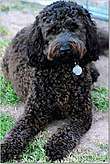Outcrossing
Out-crossing or out-breeding is the technique of crossing between different breeds with no common ancestors. This is the practice of introducing unrelated genetic material into a breeding line. It increases genetic diversity, thus reducing the probability of an individual being subject to disease or genetic abnormalities.



Outcrossing is now the norm of most purposeful animal breeding, contrary to what is commonly believed. The outcrossing breeder intends to remove the traits by using "new blood". With dominant traits, one can still see the expression of the traits and can remove those traits whether one outcrosses, line breeds or inbreeds. With recessive traits, outcrossing allows for the recessive traits to migrate across a population. The outcrossing breeder then may have individuals that have many deleterious genes that may be expressed by subsequent inbreeding. There is now a gamut of deleterious genes within each individual in many dog breeds.[1]
Increasing the variation of genes or alleles within the gene pool may protect against extinction by stressors from the environment. For example, in this context, a recent veterinary medicine study tried to determine the genetic diversity within cat breeds.[2]
Outcrossing is believed to be the "norm" in the wild.[1] Outcrossing in plants is usually enforced by self-incompatibility.
Breeders inbreed within their genetic pool, attempting to maintain desirable traits and to cull those traits that are undesirable. When undesirable traits begin to appear, mates are selected to determine if a trait is recessive or dominant. Removal of the trait is accomplished by breeding two individuals known not to carry it.[3]
Gregor Mendel used outcrossing in his experiments with flowers. He then used the resulting offspring to chart inheritance patterns, using the crossing of siblings, and backcrossing to parents to determine how inheritance functioned.[4]
Charles Darwin, in his book The Effects of Cross and Self-Fertilization in the Vegetable Kingdom, came to clear and definite conclusions concerning the adaptive benefit of outcrossing.[5]:462 For example, he stated (on page 462) that "the offspring from the union of two distinct individuals, especially if their progenitors have been subjected to very different conditions, have an immense advantage in height, weight, constitutional vigor and fertility over the self-fertilizing offspring from either one of the same parents". He thought that this observation was amply sufficient to account for outcrossing sexual reproduction. The disadvantages of self-fertilized offspring (inbreeding depression) are now thought to be largely due to the homozygous expression of deleterious recessive mutations;[6] and the fitness advantages of outcrossed offspring are thought to be largely due to the heterozygous masking of such deleterious mutations.
References
- Sharp, C.A. (26 February 1999). "The Downside of Inbreeding: It's Time For a New Approach". Canine-Genetics.com. Double Helix Network News Vol. VII, No. 1 (Winter 1999). Archived from the original on 26 January 2012.
- "Feline Genetics". UC Davis Veterinary Genetics Laboratory. Archived from the original on 2009-03-12.
- David M. Hillis. "Inbreeding, Linebreeding, and Outcrossing in Texas Longhorns". University of Texas at Austin.
- "Mendel's Paper (English - Annotated)". www.mendelweb.org.
- "Darwin, C. R. 1876. The effects of cross and self fertilisation in the vegetable kingdom. London: John Murray". darwin-online.org.uk.
- Bernstein H, Hopf FA, Michod RE (1987). "The molecular basis of the evolution of sex". Adv. Genet. 24: 323–70. doi:10.1016/s0065-2660(08)60012-7. PMID 3324702.